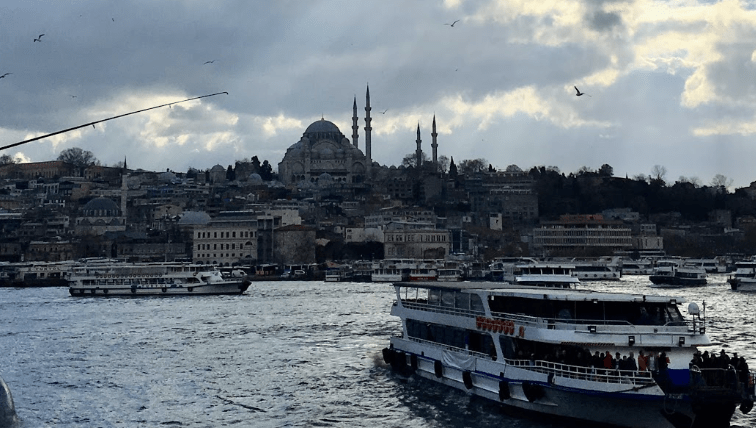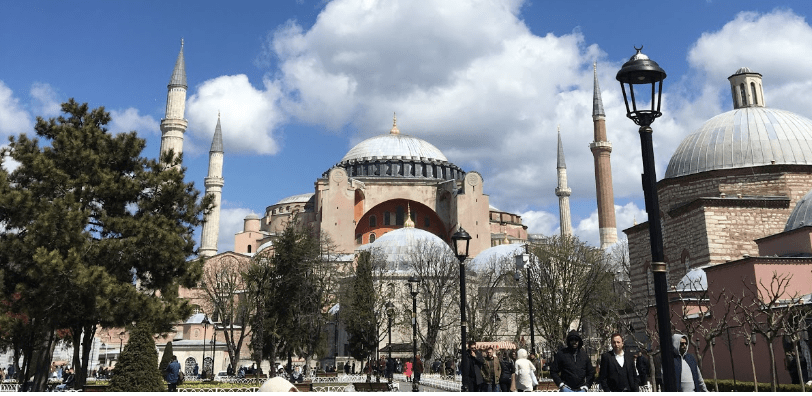by Johanna Dong
Istanbul, Turkey’s largest population hub and once the capital of the Ottoman Empire, is a city steeped in historic importance. It straddles the geographic divide between continental Europe and Asia; until the fall of the thousand-year-old Byzantine Empire in the fifteenth century, it was known as Constantinople, once considered the greatest city in all of Europe. Istanbul today is the image of bustling metropolitan modernity, punctuated here and there by the bones of the old city.

For our long weekend in Istanbul we stayed along the west bank of the Golden Horn in Balat, one of the oldest neighborhoods in the city. It was an hour’s walk from there to the main sightseeing spots in Fatih, and along the way I noticed the ruins of stone walls, half-standing fortresses, and even an aqueduct, all side-by-side with shopfronts and apartments. The walk was long and mildly terrifying due to the fact that Istanbul’s sidewalks are prone to ending abruptly, occasionally leaving one stranded at the edge of a highway. But with enough persistence and a willingness to jaywalk across six lanes, we made it to all our destinations.
Number one on the sightseeing priority list for Istanbul is undoubtedly its mosques. Their domes and minarets are quite literally ethereal in the sunlight, rising from the city skylines like palaces from myth. For someone like me who has never before seen this particular style of architecture, these grand mosques appear almost unreal. We visited Istanbul’s three most famous mosques: the Hagia Sofia (or Ayasofya), the Blue Mosque (or Sultanahmet Camii) and the Süleymaniye Mosque (or Süleymaniye Camii).

I personally have wanted to see the Hagia Sofia for years; once known as the grandest Christian cathedral in the days of Constantinople, it is a marvel of architecture with its massive central dome. The Ottomans converted it into a mosque upon the conquering of Constantinople, and in 1935 it was converted again into a museum.
Unlike the Hagia Sofia, the Süleymaniye and Blue Mosques still retain their religious functions—as such, they close five times a day for prayer. While both are absolutely worth a visit, the Blue Mosque is far more crowded while the Süleymaniye Mosque is blissfully quiet and even recruits local volunteers to talk to visitors about the structure’s history and significance. In my opinion, Süleymaniye was the highlight of my trip—it provides a gorgeous view of the city and the Bosphorus Strait, features the actual tombs of Sultan Suleiman I and his various family members and is the second-largest mosque in Istanbul.
Other notable excursions included Topkapi Palace, now a museum and located next to the Hagia Sofia and Blue Mosque, a two-hour/two-dollar boat cruise along the Bosphorus Strait (which forms the divide between Istanbul’s European and Asian sides), the Grand Bazaar and Spice Bazaar and some very excellent Turkish coffee and baklava.
For me, however, the most fascinating part of my trip to Istanbul was simply experiencing a culture so different than anything else I’ve ever been exposed to. Sometimes these cultural differences bordered on uncomfortable—as an Asian person, for instance, I certainly stuck out like a sore thumb no matter where I went. I also tend to feel self-conscious, exposed in some way, whenever I fall so distinctly into the category of tourist. But such experiences are a vital element of traveling, and the trip as a whole was a field education in culture, history and perception.

